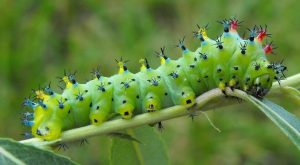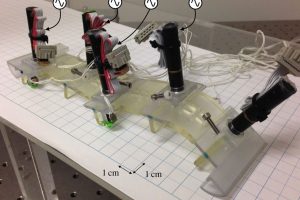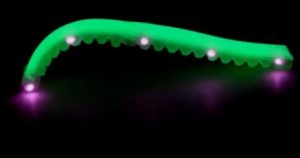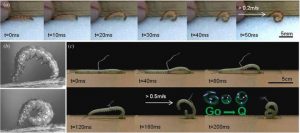Researchers are working on a robot, inspired from the caterpillar that may be used to monitor the environment in the near future.

Why would anyone make a robot designed like a caterpillar?
Normally robots are made of rigid materials, which are vulnerable to damages caused by twisting, falling or even scraping. Also, the hard parts cannot squirm past any obstacles on their way. To avoid such problems researchers are planning to design a robot made of soft, flexible plastic or rubber that resembles a caterpillar.

For several years scientists have tried to gain inspiration from Nature. Boneless creatures like octopuses, worms, caterpillars, and starfish have inspired scientists to design a bendable robot that can wriggle past objects that stand on its way. Flexible robots made of soft elements are easy to interact with and less harmful than those made of hard materials. And also, they are more resistant to damage due to falling or external factors.
But soft materials like rubber or plastics deform easily, which is why controlling a robot made of such elements, by conventional techniques can be very difficult. Also, it is not easy to model or predict the activity of bendable materials, since it involves vast computational technologies and application, thereby, making the entire system even more complicated. So after analyzing the caterpillars of tobacco hornworm scientists have been successful come up with a solution for the problems they faced while designing a robot made of bendable material.
Their study on caterpillars revealed that their complex movements, without any hard skeleton, were not brought by using brain functions. The movements of the caterpillar are not relied upon their brain (since they have very ill-developed nervous system), but on decentralized body parts which control the movement as a whole. The caterpillars have their sensory neurons in the soft tissues which can pass on the data to muscles that ultimately help the insect to move.
Robots that have taken inspiration from the different movement of caterpillars:
Wriggling locomotion:
In an ongoing project in the University of Tokyo, Takuya Umedachi and his team attached sensors to the soft body of the robot. Due to certain interactions with the environmental factors, the material deformed, and the data collected by sensors were sent to the processor, which controls the motors of the robot, and the motor. As a result contracts the robot body’s any of the four segments for its movement. The information that was collected by the implanted sensors could guide the robot’s motions.

Umedachi intends to make a robot that can wriggle through the branches of a tree and collect temperature, humidity and other relevant weather information with the help of cameras and sensors built into it.
Ballistic rolling:
According to a study published n April 27 in Bioinspiration & Biomimetics, researchers from Tufts University, Massachusetts, have developed a robot which takes inspiration from the ability of a caterpillar to roll themselves into a wheel as a part of their escaping mechanism. Mimicking the “ballistic rolling” process, one of the fastest curling behaviors in nature, the researchers developed a 3-inch long robot made of Silicon rubber, named ‘GoQbot’ (‘Q’ refers to the shape the robot makes while curling). This particular research is potential enough to provide a blueprint for the future of robotics.
The robot also has embedded memory alloy coils and can roll away at a speed of half a meter per second and each role covering a distance of around 10 inches. The robot has motion tracking abilities, performed by 5 Infrared emitters fitted along its side, and high speed three-dimensional tracking technologies. A force plate measures the detailed ground forces when the robot curls into a roll.


The lead author of the project, Huai Ti Lin, believes that his works have laid the foundation stone of the future robots that will be able to move fast and also wriggle in limited spaces. The increased speed of these robots, coupled with increased range and rolling capabilities can be used for various applications. The robots can be deployed at disaster sites so that they can initiate the rescue process by collecting information from the debris or inspecting the remnants or monitoring the environmental factors.


















